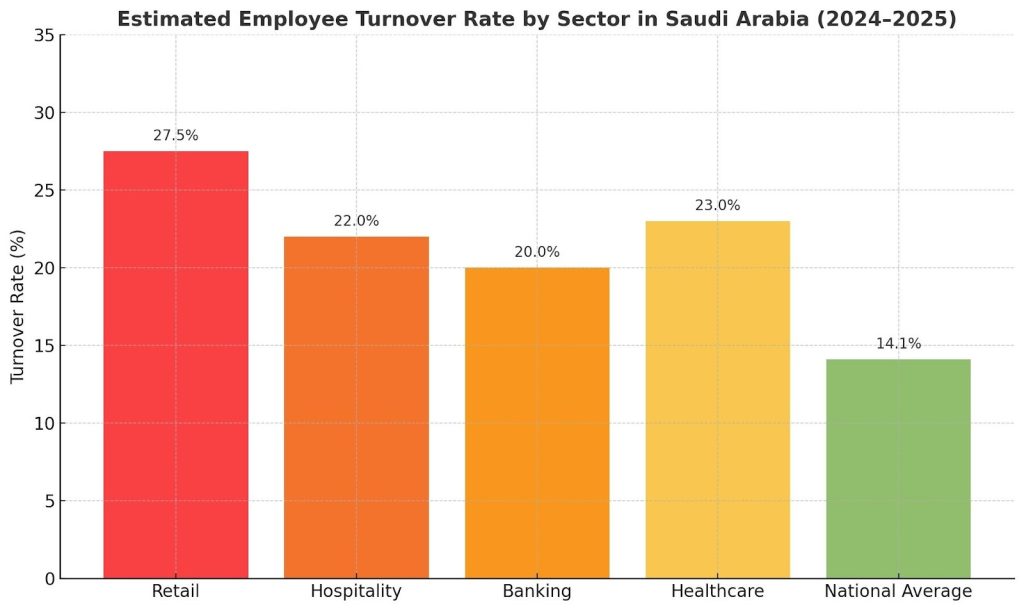The costs associated with high employee turnover go far beyond recruitment and training expenses. Turnover often represents a silent drain on talent, experience, and company culture- ultimately damaging your employer brand, especially in a highly competitive job market like Saudi Arabia’s.
Many decision-makers are beginning to take notice and implement reforms. However, numerous companies still make common mistakes when calculating their turnover rate. What are these mistakes? And what are the proven strategies to reduce turnover? Let’s dive in.
What Is Employee Turnover Rate and How Do You Calculate It?
Employee turnover rate refers to the percentage of employees who leave your company during a specific period – whether due to voluntary resignation or employer-initiated termination. It’s typically measured annually.
The Accurate Formula for Calculating Turnover Rate
While there are several valid ways to calculate turnover, the following method is both accurate and straightforward:
| (Number of employees who left during the year) ÷ [(Number of employees at the beginning of the year + Number of employees at the end of the year) / 2]= (result) × 100 = Employee Turnover Rate (%) in your company over the year |

Accurate formula for calculating employee turnover, as cited from nailted.
Example Calculation:
In 2024, your company had 105 employees at the start of the year and 123 at the end.
105 + 123 = 228 ÷ 2 = 114 (average number of employees)
Let’s say 13 employees left during the year.
13 ÷ 114 = 0.11 × 100 = 11%
Your turnover rate for 2024 is therefore 11%.
Tip: You can calculate turnover for any time frame – monthly, quarterly, or semi-annually – using the same formula.
What are the common mistakes companies make when calculating employee turnover rate?
1. Counting Only Voluntary Resignations
Some organizations only account for voluntary resignations and exclude terminations or layoffs initiated by management. However, for a true picture of workforce stability, it’s important to include both voluntary and involuntary departures in your calculations.
There are two main types of turnover:
- Voluntary turnover – when employees choose to resign.
- Involuntary turnover – when the company initiates terminations or layoffs.
Both should be included to get an accurate average turnover rate.
2. Not Differentiating Between Saudi and Expat Employees
A common oversight in Saudi companies is failing to distinguish between the turnover causes for Saudi nationals and expats.
Why is this Wrong? Because when a high-performing Saudi employee leaves, the impact is often greater, it’s not just a loss of talent, but it can also affect your Saudization compliance. In smaller companies, even a few departures can shift your Saudization classification, and this impact can be amplified in larger organizations if it becomes a recurring issue.
Best Practice: Calculate the overall turnover rate for your entire workforce, but also separately track turnover for Saudi nationals and for expats. Analyze the reasons behind each to develop targeted retention strategies.
3. Inconsistent Use of Formulas Across Departments
Different departments may use different formulas to calculate turnover, leading to inconsistencies and unreliable data. It’s crucial to standardize the calculation method across the organization to ensure accuracy and effective decision-making.
4. Ignoring Related Metrics
Turnover doesn’t exist in isolation. Ignoring related indicators, like job satisfaction, absenteeism rates, and annual employee feedback surveys, can result in a missed opportunity to understand and address root causes of turnover.
What are the average turnover rates for different sectors in Saudi Arabia in 2024–2025?
Employee Turnover Rate in the Retail Sector:

The turnover rate is estimated to range between 25% and 30%, which is significantly higher than the global average of 15–20%.
This elevated rate is largely due to intense competition from the hospitality and entertainment sectors for the same workforce, low wages, limited career advancement opportunities, and frequent staff replacement, particularly among female employees.
[Source: Quest Search & Selection – 2024]
Hospitality Sector:
The employee turnover rate in the hospitality sector is also considered high, although precise figures are not consistently reported. Key contributing factors include long working hours and low job satisfaction among Saudi employees.
Banking Sector:
There is a high level of turnover intention among employees, meaning that a significant number of employees are considering leaving their jobs, even if they haven’t actually done so yet.
The main reasons behind this trend include increased workload, low organizational commitment, and a lack of clarity about individual roles.
Even the intention to leave, in itself, has a negative impact on productivity, which has been shown to decline noticeably in such cases.
[Source: BMC Psychology – 2024 study on banking employees in Saudi Arabia]
Healthcare Sector:
The healthcare sector in Saudi Arabia is experiencing a rise in both actual turnover and turnover intention, particularly within hospitals.
The key drivers of this trend are occupational burnout and low employee satisfaction. [Source: Multiple academic studies analyzing turnover trends in Saudi healthcare institutions]
The overall employee turnover rate in Saudi Arabia stands at 14.1%, making it the highest among GCC countries during 2023–2024. [Source: Procapita Annual HR Report for the GCC (2024)]
What are the Top Strategies to Reduce Employee Turnover?
1. Invest in HR Tools That Accurately Track Turnover
Modern HR software solutions can automatically calculate turnover rates using real-time data. However, many lack Arabic language support and may not be cost-effective for small businesses.
Here are a few examples:
- BambooHR and Bayzat: Ideal for small to mid-sized companies, offering a balance between functionality and cost.
- Oracle HCM Cloud and SAP SuccessFactors: These are premium enterprise-level solutions, better suited for large corporations with higher budgets.
- Factorial and Zoho People: Cost-effective solutions tailored for organizations with limited budgets.
2. Invest in Enhancing the Candidate and Employee Experience Within Your Company
- Let’s begin with the importance of cultivating a healthy, positive, and motivating work environment—one that encourages productivity and fosters team collaboration. This should be prioritized even before enhancing the financial benefits package.
Many companies in the Middle East place excessive focus on compensation and perks, often at the expense of the work environment. The result is a workplace known for high salaries but plagued by internal issues stemming from intense competition over these financial rewards. Such environments often fail to generate sustainable growth or retain true talent. Employees are left to choose between preserving their mental and emotional well-being by leaving the company, or staying for the benefits while enduring low morale and reduced productivity.
- That said, improving the benefits package – including medical insurance and end-of-service benefits – is still essential, and it should extend to both local and expatriate employees. Given the highly competitive labor market for skilled professionals in Saudi Arabia, it’s important that your benefits package not only competes with companies in your own sector but also stands strong against those in other industries.
- Invest in delivering a positive candidate experience. This means optimizing every stage of the recruitment process, even for candidates you don’t end up hiring. A candidate who has a good experience with your company today may become a valuable hire in the future – or could even refer to someone who is an even better fit.
3. Partner with Workforce Solutions Experts in Saudi Arabia: SMASCO
SMASCO provides a comprehensive range of services to help you stabilize your workforce—from temporary staffing to permanent professional hiring, along with full recruitment and payroll solutions.
While you focus on your operational goals, we handle your staffing challenges with precision, reducing human error, increasing employee satisfaction, and ultimately, decreasing turnover.
We’re not just a service provider, we’re a strategic partner in your company’s growth. Connect with SMASCO experts today.
FAQs:
How is employee turnover calculated?
By dividing the number of employees who left during a given period (e.g., a year) by the average number of employees during that period, then multiplying by 100 to get a percentage.
What’s a normal turnover rate?
There’s no one-size-fits-all answer. It varies by sector, region, and employee type (expats vs. nationals). The key is to benchmark against your sector’s average in your country—and then improve from there.
What are the most effective ways to reduce turnover?
The most effective approaches are comprehensive, proactive strategies—such as improving the internal company culture among employees, enhancing the overall work environment, and fostering a strong sense of teamwork. Offering competitive compensation and benefits packages, investing in employee training and development, and ensuring the presence of effective leadership that genuinely supports its team are also crucial. The key is to make employees feel valued and see themselves as integral to the company’s success.

